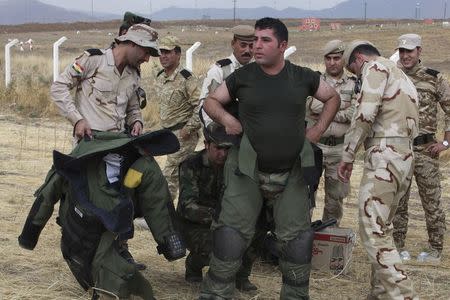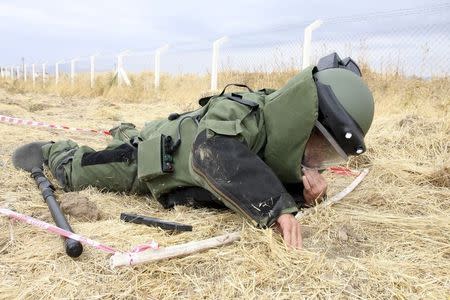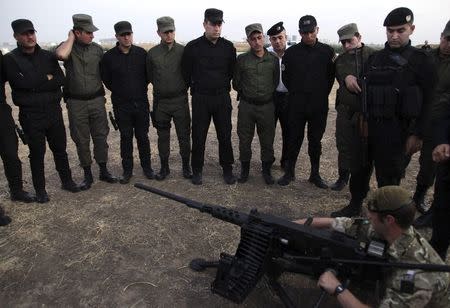Bomb training vital as Kurds retake Islamic State ground in Iraq
By Isabel Coles NORTHERN IRAQ (Reuters) - Weighed down by a giant protective suit, the Kurdish fighter cautiously approached a pick-up truck to defuse the bomb concealed inside by Islamic State militants. The tension feels real although it is a mock scenario, part of a month-long course for Kurdish forces, who are being trained to detect and defuse explosives on the battlefield by a private company contracted by the British Ministry of Defence. "In this drill, the police chief of a town has seen something suspicious under a seat in his car, so he's asked the bomb disposal team to take a look and render the device safe," explained one of the instructors, all of whom are British veterans of the Iraq war. In another exercise, a trainee wearing the same protective suit painstakingly traces a wand through the air in front of him, focusing his eyes on its point to help spot any trip wires. It is one of the few examples of assistance provided by Western countries to Kurdish forces fighting Islamic State militants who control vast tracts of both Iraq and Syria, and is also emblematic of their careful engagement there. Haunted by the legacy of the Iraq war and wary of being sucked into the conflict, Britain and other Western countries have ruled out sending troops again, but are bombing Islamic State targets from the sky while providing arms and training to forces on the ground. Britain, the main battlefield ally of the United States during the invasion of Iraq a decade ago, has been particularly cautious this time around, waiting nearly two months after U.S. air strikes began to commit its first six planes to the fight. So far, Britain has sent just 40 machine guns to Iraq's Kurds and a small group of soldiers to teach fighters how to fire them. Kurds say they need much heavier weapons such as tanks and attack helicopters to take on Islamic State fighters who plundered a massive arsenal of U.S. equipment surrendered by the Iraqi army when it collapsed in the north in June. Nevertheless, Kurdish officers say the bomb disposal training is an important example of how Western military expertise could help them gain an upper hand. Kurds have been regaining territory from Islamic State in northern Iraq since the U.S.-led air strikes began in August. But progress has been hindered by bombs and booby-traps. Among the Iraqi Kurdish soldiers, known as peshmerga, more than half of those killed have been victims of homemade bombs. On more than one occasion, the Kurds have retaken a town only to relinquish it again because of mines and counter-attacks by suicide bombers. Emerging from the suit red-faced and glazed with sweat, 28-year old Peshwar Saleh Taha, who is one of 18 peshmerga on the course, said he now felt better equipped to handle the threat of a homemade bomb, known as an improvised explosive device or IED. "They (the trainers) are experienced and we have benefited a lot. The war we are waging against IS is all about bombs and IEDs. It's very important we learn how to deal with them so we can clear the way for the peshmerga to advance." EVOLVING THREAT "The IED threat is significant, it's growing and it's continually evolving," said Simon de Gruchy, managing director of Explosives Risk Management, the British company running the course. Reuters was shown the training centre on condition its location in Iraq's northern autonomous Kurdistan region not be disclosed for security reasons. "We have to keep up with their technology battle as much as they have to keep up with the counter measures we put in place to disrupt IEDs." Islamic State fighters are already adapting their tactics and concealing IEDs in increasingly unlikely places. On one front line, the militants booby-trapped their own black flag so it would blow up when anyone tried to remove it after they left. In another village, peshmerga said a mosque loudspeaker had been rigged with explosives that would detonate when it was next used to call worshippers to prayer. Opening a fridge in a house temporarily occupied by the militants can trigger a blast. Whereas the militants used to plant IEDs in an area to cover their retreat, they are now advancing to plant mines before pulling back. One peshmerga commander said his men had come across as many as 500 IEDs in an area no larger than 4 kilometres square. "They have occupied large areas and they can't control them, so they resort to IEDs," said peshmerga Colonel Omar Jalal at the training centre. Jalal said the peshmerga had been ill-prepared to tackle the threat of IEDs, with only a few squads equipped to detect and dismantle them. Militants have begun carrying out more complex attacks, where an initial explosion is followed by a small arms assault, or further devices are used to target reinforcements. Suicide bombers may also be sent to blast through the wall of a compound or base, making way for a secondary offensive. "It's something we've seen in Afghanistan and we're starting to see here now," Gruchy said. (Editing by Peter Graff)




